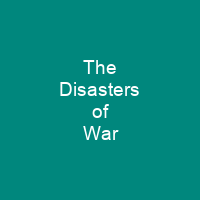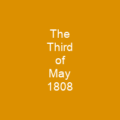The Disasters of War: A Visual Protest Against Violence
Imagine a series of prints that capture the raw, unfiltered truth of war—its horrors, its cruelty, and its impact on individuals. This is precisely what Francisco Goya’s The Disasters of War does. Created between 1810 and 1820, these 82 etchings are a powerful visual protest against the violence of the Dos de Mayo Uprising, the subsequent war, and the restoration of the Bourbon monarchy in Spain.
Why were these prints not published until 35 years after Goya’s death? The answer lies in their critical nature towards both French invaders and the restored Bourbons. These works dared to challenge the status quo, making them too controversial for public release during Goya’s lifetime.
The Disasters of War: A Break from Tradition
Goya’s series breaks away from traditional Spanish war art by focusing on the effects of conflict on individuals rather than glorifying battles or heroes. He uses shadow and shade instead of color to create a somber, almost theatrical atmosphere. The prints are divided into three groups: incidents from the war, famine in Madrid, and the disappointment of liberals after the restoration.
During this period, Goya painted little aside from portraits and allegorical works, including those of Napoleon and Wellington. He also worked on drawings for The Disasters of War, which reflected his perception of the Spanish resistance’s dismemberment.
A Diverse Collection of Prints
The Disasters of War is divided into three thematic groupings: war, famine, and political and cultural allegories. The plates were created in a sequence that reflects the order in which they were made, but their chronology has been established through identifying incidents and batches of plates.
Both French and Spanish troops tortured and mutilated captives; civilian death is captured in detail. Spanish women were victims of assault and rape, while civilians often followed armies to battle scenes. If they lost, they fled in fear. A group of plates depicts atrocities, with Spanish civilians fighting back against the French. The series focuses on anonymous casualties rather than individual patriots.
Allegorical Scenes and Satire
The prints also contain allegorical scenes that comment on the Inquisition, torture, and the repressive nature of the new regime. Many of these images return to Goya’s earlier Caprichos style, with satirical verses drawing from Giovanni Battista Casti’s fable ‘Animal Farm.’ Some plates critique idolatry of religious images, particularly statues and processional images, showing them as mundane and powerless.
The series ends with a portrayal of a woman wearing a wreath, intended to represent Spain or the Constitution of 1812, which was rejected by Ferdinand VII in 1814. In plate 80, Si resucitará? (Will she live again?), she is shown lying on her back with breasts exposed, bathed in a halo of light before a mob of ‘monks and monsters.’ In plate 82, Esto es lo verdadero (This is the true way), she is again bare-breasted and apparently represents peace and plenty. She lies in front of a peasant.
The Artistic Process
Goya began to experience shortages of good quality paper and copper plates, leading him to destroy some etched and aquatinted landscapes. He completed 56 plates during the war against France, which are often viewed as eye-witness accounts. A final batch of plates was likely produced after the end of the war, when materials were more abundant.
Goya used a sketchbook when visiting battle sites and then set to work on copper plate once he had absorbed and assimilated meaning from his sketches. All drawings are from the same paper and all copper plates are uniform. The titles of some scenes link pairs or larger groups, even if the scenes themselves are not related.
Impact and Legacy
The Disasters of War was not published during Goya’s lifetime possibly due to political repercussions or censorship. Over 1,000 impressions of each print have been printed with later editions showing wear to the aquatint. The series follows a European tradition of war art and its examination of the effect on civilian life.
It is influenced by Dutch depictions of the Eighty Years’ War with Spain and 16th-century German artists like Hans Baldung. Goya’s work, including Esto es peor (This is worse), subverts classical motifs through his use of black theatre and graphic line. He abandons color to convey truth through light, shade, and shadow.
The series features recurring pictorial themes such as darkened archways, street corners with cruelty, and silhouetted hilltops carrying the dead. The Disasters of War is Goya’s second major print series, completed between 1815 and 1816. It depicts life-and-death scenes of war without the glory or picturesqueness of traditional narratives.
Modern Interpretations
The Disasters of War had no impact on European consciousness for two generations until its publication in 1863. Since then, interpretations have reflected the sensibilities of the time. Goya was seen as a proto-Romantic, influencing artists such as Théodore Géricault and Luis Buñuel. The series’ impact is also evident in Salvador Dalí’s work, particularly in Soft Construction with Boiled Beans.
In 1993, Jake and Dinos Chapman created 82 miniature sculptures modeled on The Disasters of War, which were widely acclaimed and purchased by the Tate gallery. For decades, Goya’s series served as a constant point of reference for the Chapman brothers, who created variations based on the plate Grande hazaña! Con muertos!
In 2003, artists Chapman brothers exhibited altered versions of Goya’s prints ‘The Disasters of War’ by replacing the original images with demonic clown and puppy heads to draw a connection between Napoleon’s introduction of Enlightenment ideals and modern-day politicians’ claims to bring democracy.

The Disasters of War remains a powerful and poignant reminder of the human cost of conflict. Through his unflinching gaze, Goya invites us to confront the darkest aspects of humanity and the enduring impact of war on society.
You want to know more about The Disasters of War?
This page is based on the article The Disasters of War published in Wikipedia (retrieved on November 29, 2024) and was automatically summarized using artificial intelligence.







